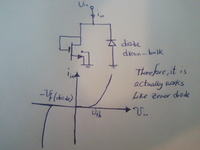HarryH00t
Newbie level 5

Hey guys,
if I'm using a Diode connected MOS (Gate and Drain connected), where does the reverse current come from? It is clear that the MOS will conduct when Vgs = Vds = Vd reaches the threshold voltage of the MOS.
If I apply a negative voltage to the "diode", I can switch Drain and Source(since they are actually the same). Then Source is connected to Gate, which results in Vgs being 0V. Vds is positive then(negative for the "diode"). Many formulas give Id = 0 when Vgs < Vth, but I can measure Drain-current anyways. Where does this come from? Is this weak inversion? I always thought weak inversion occurs for positive Vgs which are smaller than Vth.
think you can help me out
Harry
if I'm using a Diode connected MOS (Gate and Drain connected), where does the reverse current come from? It is clear that the MOS will conduct when Vgs = Vds = Vd reaches the threshold voltage of the MOS.
If I apply a negative voltage to the "diode", I can switch Drain and Source(since they are actually the same). Then Source is connected to Gate, which results in Vgs being 0V. Vds is positive then(negative for the "diode"). Many formulas give Id = 0 when Vgs < Vth, but I can measure Drain-current anyways. Where does this come from? Is this weak inversion? I always thought weak inversion occurs for positive Vgs which are smaller than Vth.
think you can help me out
Harry


